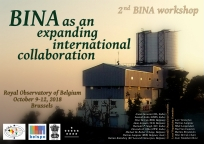Speaker
Dr
Patricia Lampens
(Koninklijke Sterrenwacht van België)
Description
The oEA stars are the former secondaries of evolved, semi-detached eclipsing binaries which are (still) undergoing mass transfer and form a newly detected class of pulsators close to the main sequence (Mkrtichian et al. 2002). Their unique feature consists of mass accretion onto the atmosphere of the pulsating star. Mass accretion affects the mass, radius, density as well as the star's evolution (depending on the accretion rate). Such stars are therefore very attractive targets for asteroseismic studies. The eclipse mode identification method for EBs with pulsating components was suggested by Nather & Robinson (1974). The method uses the primary eclipse event as a spatial filter to resolve the pulsations across the stellar surface of the pulsator. It is based on the fact that, during an eclipse of the pulsating component, the occulting star acts as a screen with a timely variable shape. During an eclipse, depending on the (l,m) spatial structure of modes, different shapes of the pulsation amplitude and phase variations are observed. A comparison between the modelled and the observed amplitude and phase patterns provides the correct mode identification. The method (also called dynamic eclipse mapping method; Bíró et al. 2011) needs a geometrical model, pulsation frequencies as well as the light curves as input. The geometrical model can be obtained from a simultaneous modelling of the light (photometry) and radial velocity curves (acquired with the HERMES spectrograph). The pulsation frequencies are obtained from subtracting a binary model from the original light curves followed by a frequency analysis of the residuals. We will identify and illustrate systems where observations with a (relatively) fast CCD camera equipping the 3.6-m Devasthal Optical Telescope (DOT) could deliver the data needed for the application of the eclipse mapping method.
Primary author
Dr
Patricia Lampens
(Koninklijke Sterrenwacht van België)
Co-authors
Ms
Lore Vermeylen
(Royal Observatory of Belgium)
Dr
Peter De Cat
(Royal Observatory of Belgium)

